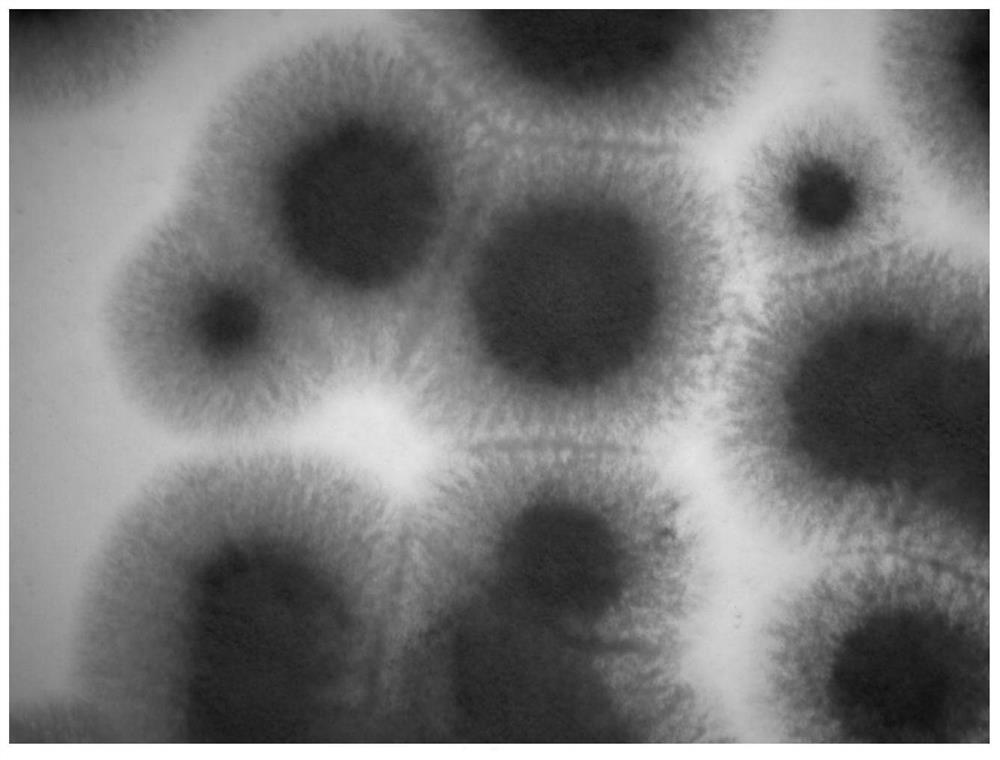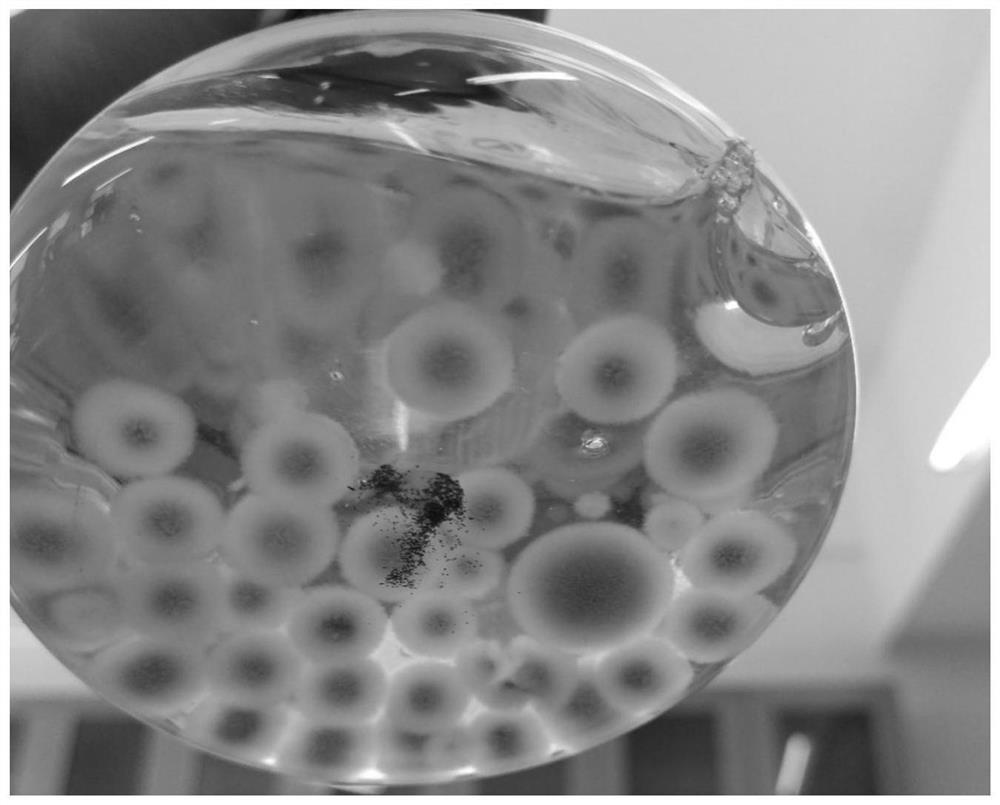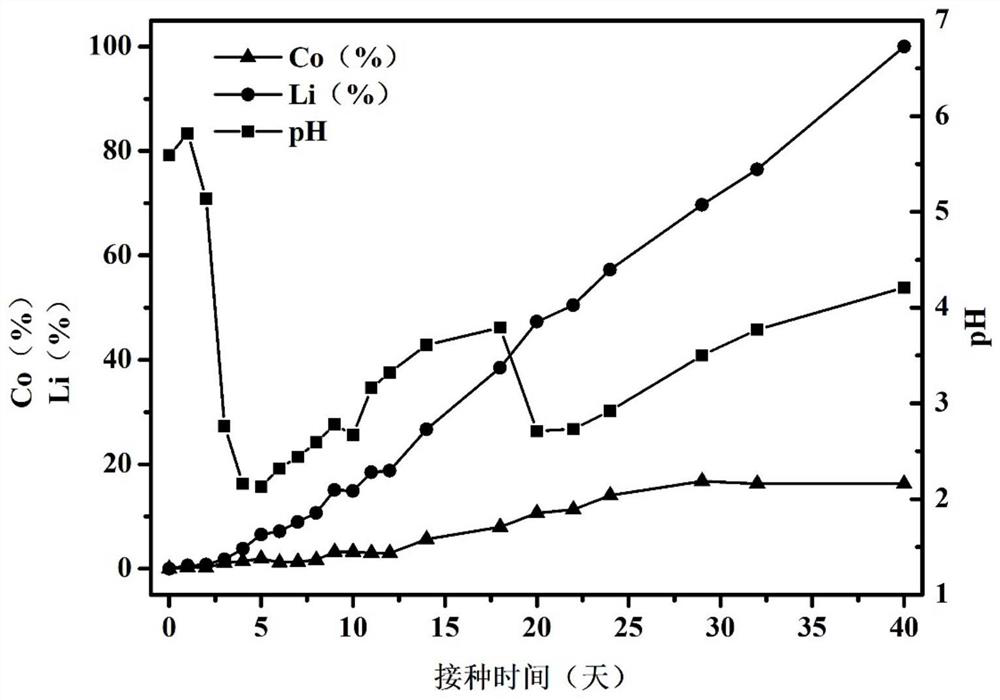A strain of Penicillium oxalicum and its cultivation method and application
A Penicillium oxalicum, culture method technology, applied in the direction of microorganism-based methods, biochemical equipment and methods, fungi, etc., can solve the problem of less fungus, achieve strong tolerance, reduce process scale, and reduce investment costs Effect
- Summary
- Abstract
- Description
- Claims
- Application Information
AI Technical Summary
Problems solved by technology
Method used
Image
Examples
Embodiment 1
[0027] Isolation and acclimation screening to obtain Penicillium oxalicum SYJ-1:
[0028] (1) Collect soil from the surface layer of the sewage outlet of the lithium battery factory in Mianyang City, Sichuan Province, immediately store it at low temperature and bring it back to the laboratory, take 1 cm 3 The soil was in 100mL sucrose medium (medium composition: sucrose (100g / L), yeast extract powder (1.6g / L), NaNO 3 (1.5g / L), KH 2 PO 4 (0.5g / L), MgSO 4 ·7H 2 O (0.025g / L), KCl (0.025g / L)), and 1g / L lithium cobalt oxide powder was added to it, and cultured in a constant temperature shaking shaker at 30°C and 150r / min.
[0029] (2) After culturing for two days, the liquid shake flask supernatant was -6 , 10 -8 , 10 -10 , 10 -12 The concentration gradient was diluted, and then inoculated on a sucrose medium plate containing 2% agar, placed in a 32°C incubator for five days, and fungal colonies were picked for further screening and purification.
[0030] (3) The picked fu...
Embodiment 2
[0034] Identification of strains:
[0035] The ITS sequence of the strain was extracted with the Ezup column fungal genomic DNA extraction kit, and PCR amplification was performed to obtain an amplified product with a length of about 600 bp, which was then sequenced by a sequencing company. BLAST alignment of the detected sequence with the sequence in GenBank database shows that the strain has high homology with Penicillium (Penicillium), and the similarity with Penicillium oxalicum is more than 99%. Combined with the morphological characteristics, culture characteristics and ITS sequence analysis results, it was determined that SYJ-1 was Penicillium oxalicum.
Embodiment 3
[0037] Determination of tolerance of Penicillium oxalicum SYJ-1 to lithium cobaltate:
[0038] With eleven concentrations of 1g / L, 3g / L, 5g / L, 7g / L, 10g / L, 20g / L, 40g / L, 60g / L, 80g / L, 100g / L and 200g / L Lithium cobaltate tolerance experiments of SYJ-1 were performed in sucrose medium of lithium cobaltate. The above strain SYJ-1 was inoculated on a red Bengal plate, and after five days of culture, the spore suspension was prepared with normal saline, and the concentration of the spore suspension was determined by hemocytometer to be 9.6 × 10 4 spores / mL, according to the inoculum volume of 500 μL / bottle, inoculated into the above eleven 100 mL sucrose mediums containing lithium cobaltate with different contents, and placed in a constant temperature shaking shaker at 30 ° C and 150 r / min for culture, and cultured for 7 Days later, the formation of mycelial balls in the shake flasks was observed.
[0039] The results showed that the growth of strains existed in the shake flasks ...
PUM
| Property | Measurement | Unit |
|---|---|---|
| particle diameter | aaaaa | aaaaa |
| particle diameter | aaaaa | aaaaa |
| tolerance concentration | aaaaa | aaaaa |
Abstract
Description
Claims
Application Information
 Login to View More
Login to View More - R&D
- Intellectual Property
- Life Sciences
- Materials
- Tech Scout
- Unparalleled Data Quality
- Higher Quality Content
- 60% Fewer Hallucinations
Browse by: Latest US Patents, China's latest patents, Technical Efficacy Thesaurus, Application Domain, Technology Topic, Popular Technical Reports.
© 2025 PatSnap. All rights reserved.Legal|Privacy policy|Modern Slavery Act Transparency Statement|Sitemap|About US| Contact US: help@patsnap.com



